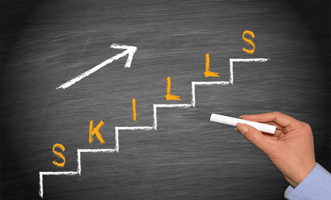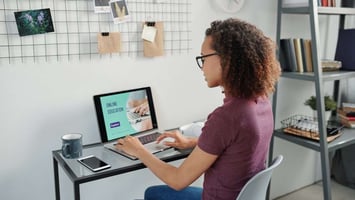At Oppida, we believe that we all need to get better at learning collectively. But how? By giving...
Digital student portfolios: a digital learning strategy
This series, entitled ‘Fostering 21st Century skills in the digital classroom’ helps teachers incorporate these skills into their lessons today. In this article, we discuss the use of digital student portfolios. If you want to find out more about 21st Century skills, check out the first two posts:
- K-12 online learning insights: what are 21st Century skills?
- Impact of digital learning on student voice
21st Century skills are becoming increasingly important in the Australian market so it’s clear we need to think about how we can incorporate them into our classrooms.
Creating a digital student portfolio can easily foster these skills. They teach six out of the eight 21st Century skills identified by the Foundation for Young Australians:
- Critical thinking
- Problem-solving
- Creativity
- Communication
- Presentation skills
- Digital literacy
A digital student portfolio doesn’t just foster 21st Century skills, educational research also suggests that a digital student portfolio enhances student learning. One study, published in the British Journal of Education Technology, found improvement in “reflection, self-assessment, continuous improvement, goal setting, problem-solving, data gathering, work, and peer interaction” (p. 358)”. It meets the gold standard of scientific methods since they used a test and a control group.
Now you know why you should use a digital student portfolio, but classroom implementation for this learning technique can be tricky. By following the tips and tricks in this article, you’ll be able to easily incorporate a digital student portfolio in your practice.

Kick digital portfolios off with a reflection
Any digital student portfolio requires people to reflect on past projects. At a minimum, people need to choose their best work.
In schools, however, most portfolios showcase growth, rather than exemplary work. So how can we help them show growth?
Teachers need to ask students to produce baseline samples.
This baseline could be a writing sample or a math problem or a checklist of the unit content. We just need to give students a way to track their learning.
Once students have a baseline, it becomes easy for them to track their growth because it is possible to compare the baseline to their results and see progress.
This phrase is also immensely useful for tracking growth:
Before I used to ______________________, but now I _________________________.
Here’s an example for numeracy of what it might look like in a digital student portfolio:
Baseline math sum with previous wrong answer: 152 + 98 = 140
Proof of Growth: 152 + 98 = 250
Imagine an eager 8 or 9-year old student voicing over the photos of their work for the above math problem: “Before I couldn’t carry numbers over in math, but now I know I need to. So 8 + 2 = 10 and I carry the ten to the next column. So, I add 90 + 60 = 150 so I carry the hundred so I add 100 + 100 so I get 250.”
This example illustrates how the student uses critical thinking skills to evaluate what they learned and the progression they made from their original wrong answer. Reflection requires students to defend the strategies they use to find answers, rather than simply regurgitating content given to them by a teacher.
Provide opportunities for goal setting
Goal setting begins once students have created a baseline and figured out what they need to learn.
But how will they know what goals to set? We call it learning precisely because people don’t understand what they don’t know. There are two ways to give students the tools to set precise goals:
- Create a blueprint
- Share exemplars
How to create a blueprint
Teachers can help students by writing (and sharing) a blueprint of the skills needed. This blueprint allows students to pinpoint exactly where they are in terms of their learning and point them in the direction they need to go. Check out Chapter 2 in the Sage Handbook of Research on Classroom Assessment for more direction on this strategy.
If a teacher also allows students to share learning strategies, they can become more creative as they peer evaluate other students’ ideas. This method has the added benefit of empowering students because they become the experts in the classroom, rather than simply repeating what they’ve already learned.
Content heavy subjects, such as science, lend themselves well to a blueprint of skills. Often students have similar misunderstandings that can be targeted with specific activities.
Sample Blueprint:
Knowledge objective: Students are asked to explain why shorter strings produce higher pitches while longer strings produce lower pitches.
To achieve this, the learning must include:
- Knowing that sound moves in waves.
- Being able to define pitch.
- Understanding that faster sound waves create higher pitches and slower sound waves produce lower pitches.
As demonstrated above, students can make a checklist of which pieces of knowledge they’ve acquired, and which pieces they are still working on.
How to provide exemplars
Not every skill can be neatly broken down into its disparate parts so these subjects benefit from exemplars.
For example, writing can often be seen as a continuum, rather than a linear journey. In fact, to the frustration of beginning writers, experts often break the rules they learned in school.
Exemplars allow teachers and students to examine what makes a text effective. After they’ve examined it, then the class can start to determine the criteria they want to use to assess their texts.
Example scenario:
A teacher may set up exemplars of a creative story at different levels. As a class, the teacher and students have discussed what strategies these texts used to be effective (or ineffective).
One student sets the goal of using more action words in her text. Then she goes to the original exemplar to compare her first draft. She may discover that she’s only added one or two action words, while the author in the exemplar added ten.
Now she has identified the problem and can set a goal to solve the issue.
She may find a thesaurus or talk to a peer or ask her teacher, but she now also has a roadmap for how to start work on solving the identified problem.
Goal setting when combined with either co-constructed criteria or a blueprint empowers students to become problem solvers, rather than teacher pleasers.
How a digital student portfolio enhances parent communication
A digital student portfolio provides wonderful evidence for parents to see how their child is doing in class.
They also create excellent opportunities for students to practice communication, presentation skills, and digital literacy. Teachers often take on the burden of communicating learning objectives to parents, but if you share these objectives with students then they can demonstrate their abilities for you.
This strategy develops presentation and digital literacy because students perform the same task multiple times. Often students only have a handful of presentations a year, but a digital student portfolio forces students to present much more frequently.
Here’s a basic routine for how you could potentially ask students to communicate with their parents via a digital student portfolio:
- State learning objective
- Show work
- Explain how the work is meeting or not meeting the objective
- Describe their next steps (if they have any)
This basic routine allows students to present their work in a contextualised way so parents know what they’re learning.
A digital student portfolio makes this type of routine easy to implement because it’s pushed directly to parents. With practice, students only need a few minutes to present their work orally to their parents while they would need significantly longer to write a paragraph and then glue it into a physical portfolio.
So there you have it, three ways that a digital student portfolio can foster 21st-century learning skills. What ways are you using digital portfolios? Do you have a favourite platform for creating them?



